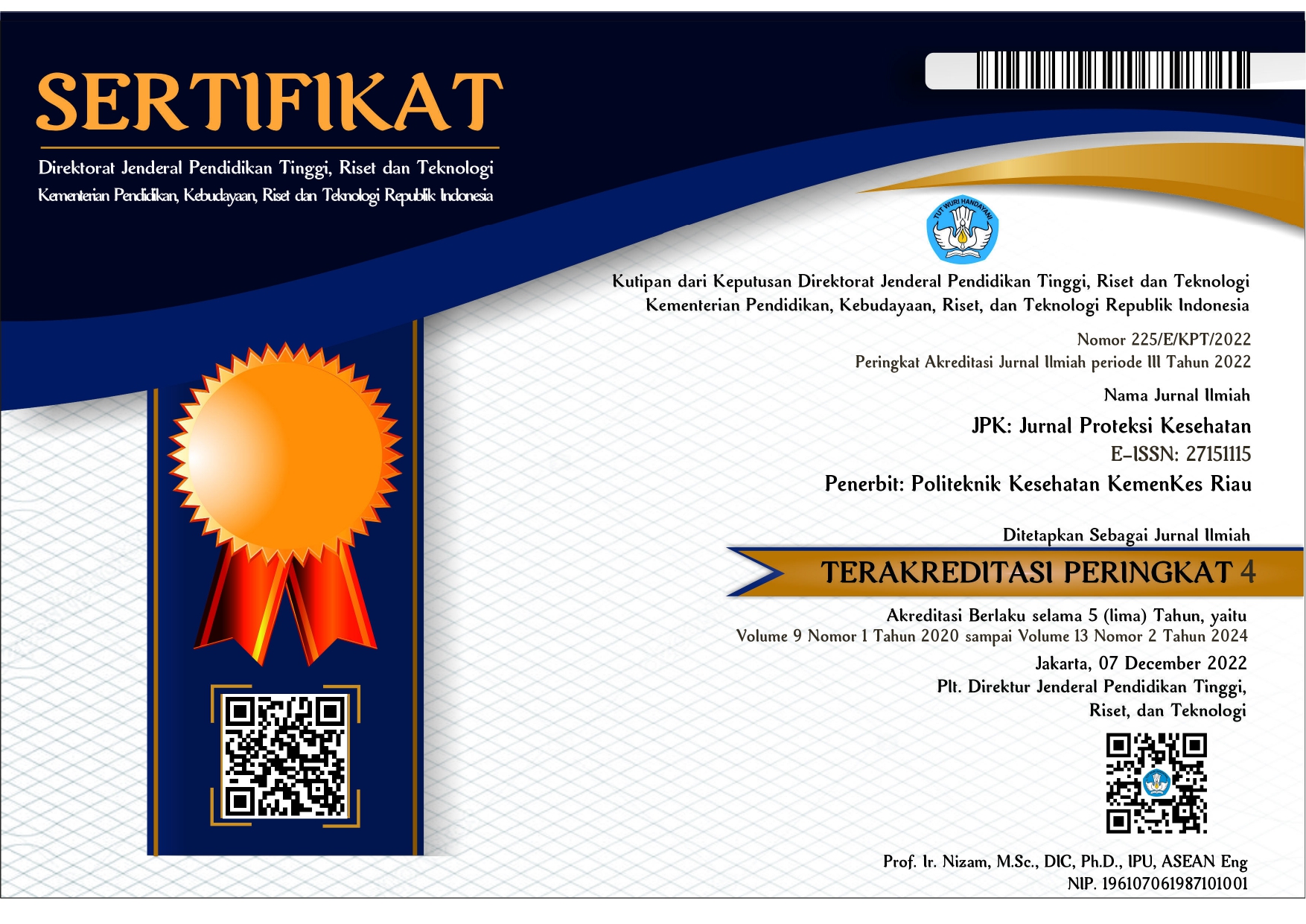Identification Lactic Acid Bacteria Potentially as Probiotic at Joruk Maman
Abstract
Tren konsumen pangan telah mengalami perkembangan dengan meningkatnya kesadaran akan kesehatan, seperti permintaan probiotik yang mulai meningkat. Indonesia kaya akan sumber bakteri asam laktat yang berpotensi probiotik. Joruk Maman merupakan makanan fermentasi khas Propinsi Riau. Joruk maman telah diketahui mengandung bakteri asam laktat. Sifat fungsional dari BAL probiotik dapat berbeda tergantung strainnya. Tujuan penelitian adalah mengidentifikasi dan karakterisasi bakteri asam laktat dari Joruk Maman. Karakterisasi BAL meliputi sifat gram, bentuk, motilitas, sifat katalase dan pengujian ketahanan terhadap kondisi pH lambung dan usus serta identifikasi dengan API Kit Tes. Hasil Penelitian menunjukkan isolat bakteri asam laktat dari Joruk Maman berbentuk batang, bakteri gram positif, bersifat katalase negatif dan non motil. BAL Joruk Maman berpotensi sebagai kandidat probiotik yaitu tahan terhadap pH lambung (2.0) dan usus (7.2) dengan ketahanan 93.07 % pada pH lambung dan 96.13 % pada pH usus serta teridentifikasi sebagai Weisella confusa.
References
E. J. Smid and L. G. M. Gorris, Natural antimicrobials for food preservation in Gálvez et al. 2014. Food Biopreservation, SpringerBriefs in Food, Health, and Nutrition. 2007.
S. Aly, O. C. A. T, B. I. H. N, and T. S. Alfred, “Bacteriocins and lactic acid bacteria - a minireview,” African J. Biotechnol., vol. 5, no. 9, pp. 678–683, 2006.
J. I. Candra, W. Zahiruddin, and Desniar, “Isolasi dan karakterisasi bakteri asam laktat dari produk bekasam ikan bandeng (,” Bul. Teknol. Has. Perikan., vol. X, no. 2, pp. 14–24, 2007.
M. C. Collado, J. Meriluoto, and S. Salminen, “In vitroanalysis of probiotic strain combinations to inhibit pathogen adhesion to human intestinal mucus.,” Food Res. Int., vol. 40, no. 5, pp. 629–636, 2007.
Food and Agriculture Organization of the United Nations (FAO) and W. H. O. (WHO), “Guidelines for the Evaluation of Probiotics in Food,” London Ontario, Canada, 2002.
D. Granato, G. F. Branco, F. Nazzaro, A. F. Faria, and A. G. Cruz, “and Nondairy Probiotic Food Development : Trends , Concepts , and Products,” Compr. Rev. Food Sci. Food Saf., vol. 9, pp. 292–302, 2010.
N. Karthikeyan, A. Elango, G. Kumaresan, T. R. Gopalakrishnamurty, and B. V Raghunath, “Enhancement Of Probiotic Viability In Ice Cream By Microencapsulation,” Int. J. Sci. Environ. Technol., vol. 3, no. 1, pp. 339–347, 2014.
Muharni and L. Restusari, “Optimization of lactic acid bacteria content in maman fermentation (Cleome Gynandra L).,” 2016.
S. A. Lindawati and I. W. Suardana, “Isolation And Identification Of Lactic Acid Bacteria Species Producing Anti-Microbial Substance Isolated From Colon Of Bali Cattle,” Vet. J., vol. 17, no. 4, pp. 576–581, 2016.
A. Nurnaafi, “Selection and characterization of lactic acid bacteria from bekasam as probiotic.,” Bogor, 2016.
I. W. Suardana, I. K. Suada, I. M. Sukada, and I. N. Suarsana, “Isolation and identification of lactic acid bacteria SR9 rumen origin of bovine cow as probiotic superior candidate,” Med. Sci. journals Indones., vol. 40, no. 2, pp. 100–103, 2009.
W. H. Lin, C. F. Hwang, L. W. Chen, and H. Y. Tsen, “Viable counts, characteristic evaluation for commercial lactic acid bacteria product,” Food Microbiol., vol. 23, no. 1, pp. 74–81, 2006.
L. Waluyo, Basic Method Techniques in Microbiology. Malang (ID): UMM Press, 2010.
R. P. Tiwari, G. S. Hoondal, and R. Tewari, Laboratory techniques in microbiology & biotechnology. New Delhi (IN): Abhishek Publication, 2009.
S. Fardiaz, “Guide to basic microbiology,” Bogor (ID), 1989.
L. Axelsson, “Lactic Acid Bacteria: Classification and Physiology,” pp. 1–66, 2004.
E. Tuomola, R. Crittenden, M. Playne, E. Isolauri, and S. Salminen, “Quality assurance criteria for probiotic bacteria 1 – 4,” Am. Soc. Clin. Nutr., vol. 73, pp. 393–398, 2001.
E. B. Minelli et al., “Assessment of novel probiotic Lactobacillus casei strains for the production of functional dairy foods,” Int. Dairy J., vol. 14, no. 8, pp. 723–736, 2004.
Y. Sanz, A. Santacruz, and P. Gauffin, “International Immunonutrition Workshop Session 8 : Probiotics in the defence and metabolic balance of the organism Gut microbiota in obesity and metabolic disorders,” Proc. Nutr. Soc., no. 69, pp. 434–441, 2010.
N. P. Shah, “Functional cultures and health benefits,” Int. Dairy J., vol. 17, no. 11, pp. 1262–1277, 2007.












